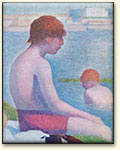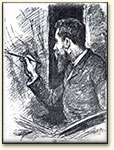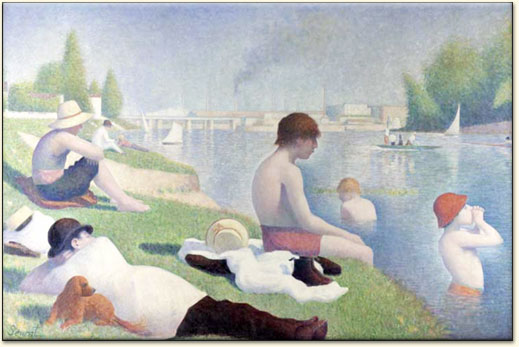Pointillism: Seurat’s Bathers at Asnières
In 1884, a young artist named Georges Seurat (1859-1891) exhibits his first large-size painting in the newly created Society of Independent Artists. Because of its size, it hangs in a bar and goes to a large extent unnoticed. Like the other artists exhibiting, Seurat’s work is refused by the official Salon. He also adopts the brilliant palette of Impressionism, their interest in open-air light effects and the realization that “local” (the actual color of an object) can be modified by atmospheric light, sunlight or by juxtaposed colors.
Like the Impressionists, Seurat and other neo-Impressionists favor scenes from modern life; from bourgeois to working class, from cafes to the circus and other forms of entertainment. Unlike the Impressionists, works such as Bathers at Asnieres are preceded by many drawings and oil sketches, a witness to Seurat’s classical, if brief, training. Two years later, Seurat works up this painting using a divisionist technique known as Pointillism.

Sketch by Seurat of a child. Notice how he fades the shading so that a shadow is against lighting, and the light area is against shadow. This heightens our sense of depth and shading – an ongoing challenge when artists try to capture the real world on canvas.
Partly as a result of his brief classical training, Seurat, like Edgar Degas (1834-1917), retains a commitment to drawing. He is also impressed by the more classically composed paintings of French artists like the Realist Jean Francois Millet (1814-1875) and the Symbolist Puvis de Chavannes (1824-1898). Unlike some contemporary Impressionists, Seurat wishes to leave nothing to chance. The painting has a blonde, clear and bright tonality, and the bridge in the distance shimmers in the haze, a result of the heat and smoky factory chimneys clouding the atmosphere. The figures of the workers enjoying the water, resting on the riverbank, are believably real. To achieve this, Seurat invokes Chevreul’s law of Simultaneous Contrast: “Where the eye sees two contiguous colors they appear as dissimilar as possible; both in their optical composition and in the height of their tone.” Thus, next to the lit sides of the boys’ bodies, where the flesh takes on an orange pink hue, the intensity of the blue in the water is darkened; next to the blue-shadowed sides of the bodies it is lightened. This can be particularly observed in the figure of the boy in the orange hat. This effect is sometimes referred to as irradiation, a phenomenon of light that makes objects stand out from one another. This is quite different from the Renaissance manner of creating three-dimensional realism, such as that found in paintings by Leonardo da Vinci, who introduced chiaroscuro to give relief to his figures. In the brilliant green grass of the riverbank there are strokes of the complementary colors, and red with hues of pink.

|

|

|
Various detailed views from Seurat’s Bathers at Asnières. |
||
Around 1886-1887, Seurat begins to apply small spots (or points) of color: blue and orange on the back of the seated bather, orange, yellow and blue on the hat of the boy in the water. Look also at the small dots of color around the hat seen against the green of the grass. This use of Pointillist color was taken far further in the Grande Jatte (see next page). Seurat read the latest books on theory of color, such as those by Blanc who quoted Chevreul as saying, “Placing color on a canvas means not only staining the color touched by the paintbrush, but also coloring the surrounding space with the complementary.” He then gives examples, such as “An orange circle will be surrounded by a blue aureole (or halo),” red circle with green, and so forth. You can see the effect of this, in the illustration shown in the entry on Chevreul’s theories.
It is important to note that Seurat also deliberately contrasts the relaxed poses of the workers in Baignade, Asnieres with the artificiality of dress and poses in the Sunday on the Island of the Grande Jatte (see next page), the self-consciously bourgeois people with their posturing animals.

